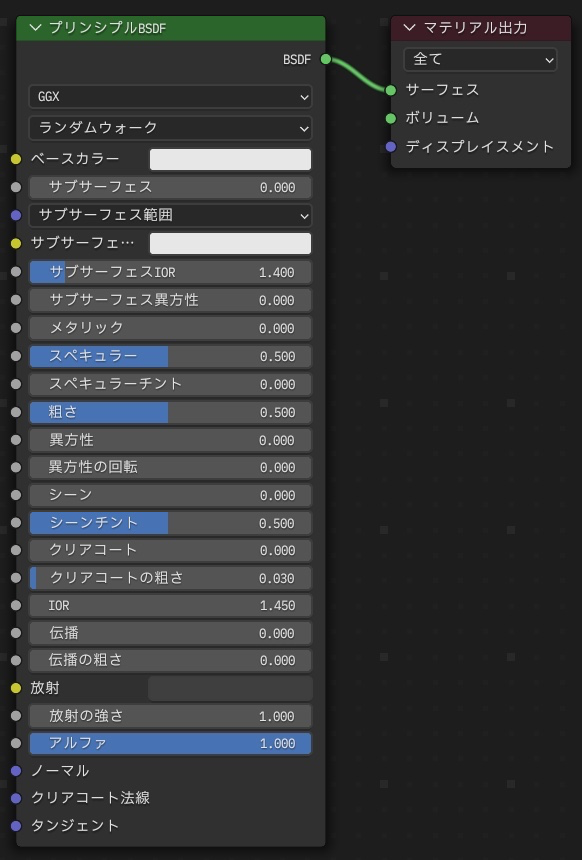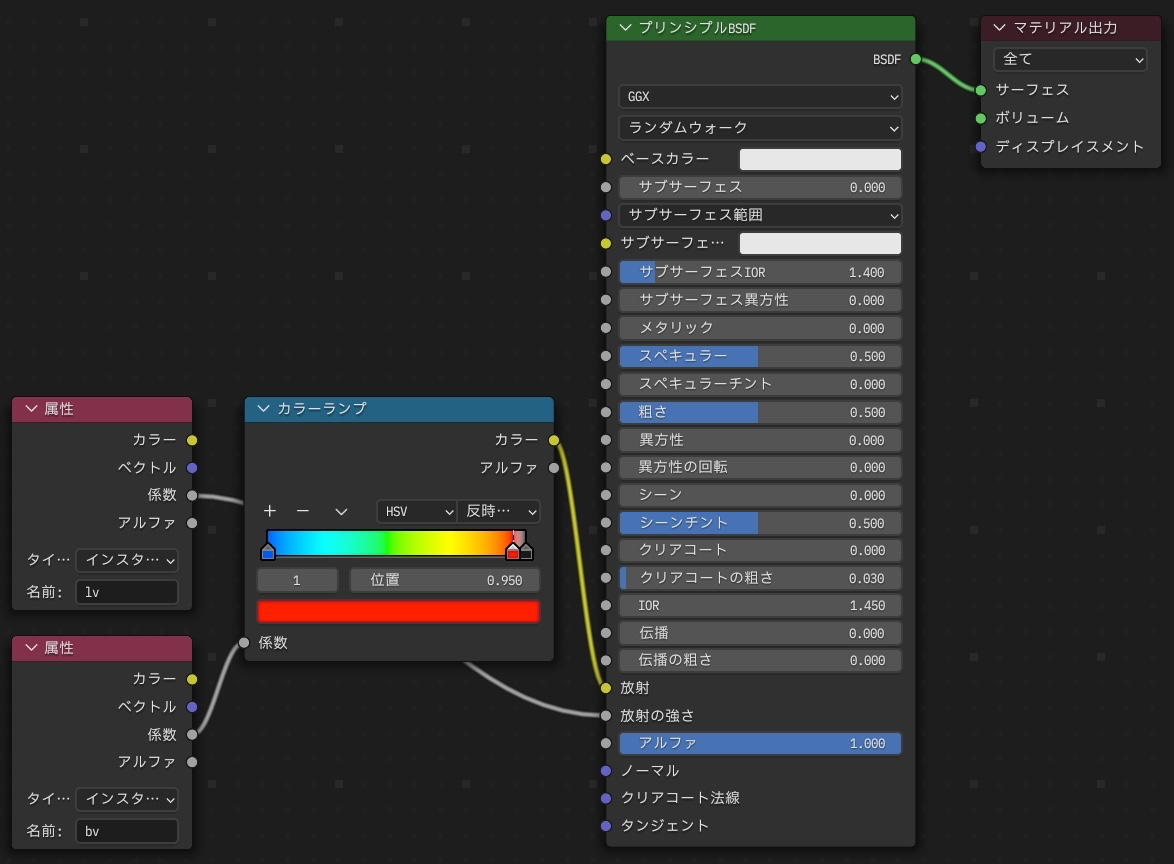Blenderで星空を作る
これなに
Blenderで下記のような星空を作る方法の紹介です。

データ
星や星座の情報は、下記のヒッパルコス星表を使います。
上記のサイトから下記の3つのファイルを使います(ダウンロードはプログラムから行います)。
-
hip_lite_major.csv:3215個の星の情報です。この中のHIP番号と赤経と赤緯と視等級(明るさ)を使います。 -
hip_100.csv:100個の星の情報です。星は上記のサブセットですが、B-V色指数が増えています。上記の表にマージします。B-V色指数は小さいと青っぽく、大きいと赤っぽく見えるそうなので、この値を使ってカラーランプで適当に色をつけます。 -
hip_constellation_line.csv:星座の線の情報です。2点のHIP番号を使います。
これらのデータから表を2つ(df、dfl)を作成します。それぞれ星と星座の線です。
考え方
下記の4種類を作ります。
- データ:サイトからCSVをダウンロードし、星と星座の2つの表を作成します。
- マテリアル:星と星座の線の2種類のマテリアルを作成します。
- ジオメトリーノード:星と星座の線のジオメトリーを作成します。
- オブジェクト:星を頂点として、星座の線を辺として作成します。
データ
データの座標は赤道座標系になってます。これをXYZ座標に変換します。
ダウンロードしたファイルはキャッシュします。
マテリアル
星座の線のマテリアル(line)
放射だけ暗いグレーに設定しています。

星のマテリアル(star)
放射と放射の強さを設定しています。それぞれ、bvとlvという属性の情報を使います。属性はオブジェクト作成時に作成しています。

ジオメトリーノード
「ポイントにインスタンス作成」でICO球を配置します。これが星を表します。
「メッシュのカーブ化」「カーブのメッシュ化」で辺を円柱にします。これが星座の線を表します。
オブジェクト
オブジェクトは、頂点と辺からなるメッシュです。面はありません。通常、面のないメッシュは見えませんが、ジオメトリーノードによって可視化しています。
ここでは下記の頂点の属性も作成し、マテリアルから利用できるようにしています。
-
bv:色指数というものです。カラーランプで使うために、0から0.94ぐらいになるようにしています。1は暗いグレーです。暗いグレーはB-V色指数を持たない星用です。 -
lv:視等級から計算しています。放射の強さに使います。
作ってみよう
pandasのインストールが必要です(下記参考)。
※ 後述の「Blender 4.4用の追記」の方法では、pandasがなくても星空を作成できます。
以下をコピーしてScriptingワークスペースで実行してください(Blender 4.0用は後述)。
"""
星表から星空を作る
"""
import time
from math import pi, tau
from pathlib import Path
import bpy
import numpy as np
import pandas as pd
def make_dataframe():
tmp = Path("/tmp")
if not tmp.is_dir():
tmp = Path("/temp")
hip_lite_major = tmp / "hip_lite_major.csv"
if not hip_lite_major.exists():
url = "http://astro.starfree.jp/commons/hip/hip_lite_major.csv"
_df = pd.read_csv(url, header=None, index_col=0)
_df.to_csv(hip_lite_major, header=None)
time.sleep(0.1)
df = pd.read_csv(hip_lite_major, header=None, index_col=0)
df.columns = "赤経時 赤経分 赤経秒 赤緯符号 赤緯度 赤緯分 赤緯秒 視等級".split()
hip_100 = tmp / "hip_100.csv"
if not hip_100.exists():
url = "http://astro.starfree.jp/commons/hip/hip_100.csv"
_df = pd.read_csv(url, encoding="cp932", header=None, index_col=0)
_df.to_csv(hip_100, encoding="cp932", header=None)
time.sleep(0.1)
usecols = [0, 1, 2, 3, 4, 5, 6, 7, 8, 12]
df100 = pd.read_csv(hip_100, encoding="cp932", header=None, index_col=0, usecols=usecols)
df100.columns = "赤経時 赤経分 赤経秒 赤緯符号 赤緯度 赤緯分 赤緯秒 視等級 BV色指数".split()
hip_constellation_line = tmp / "hip_constellation_line.csv"
if not hip_constellation_line.exists():
url = "http://astro.starfree.jp/commons/hip/hip_constellation_line.csv"
_df = pd.read_csv(url, header=None)
_df.to_csv(hip_constellation_line, header=None, index=False)
time.sleep(0.1)
dfl = pd.read_csv(hip_constellation_line, header=None)
dfl.columns = "Abbr HIP1 HIP2".split()
df = df.join(df100.BV色指数, how="left").fillna(2)
df.insert(0, "ID", range(len(df)))
df["Long"] = (df.赤経時 / 24 + df.赤経分 / 1440 + df.赤経秒 / 86400) * tau
df["Lati"] = (df.赤緯度 / 90 + df.赤緯分 / 5400 + df.赤緯秒 / 324000) * pi
df.Lati *= df.赤緯符号 - 0.5
df["Z"] = np.sin(df.Lati)
r = np.cos(df.Lati)
df["X"] = r * np.cos(df.Long)
df["Y"] = r * np.sin(df.Long)
dfl = dfl[dfl.HIP1.isin(df.index) & dfl.HIP2.isin(df.index)]
dfl = dfl.join(df.ID.rename("ID1"), "HIP1")
dfl = dfl.join(df.ID.rename("ID2"), "HIP2")
return df, dfl
def make_material(obj):
mat = bpy.data.materials.new(name="line")
mat.use_nodes = True
ndpb = mat.node_tree.nodes["Principled BSDF"]
ndpb.inputs[19].default_value = 0.05, 0.05, 0.05, 1
mat = bpy.data.materials.new(name="star")
obj.active_material = mat
mat.use_nodes = True
ndpb = mat.node_tree.nodes["Principled BSDF"]
nda1 = mat.node_tree.nodes.new("ShaderNodeAttribute")
nda1.attribute_name = "bv"
nda1.attribute_type = "INSTANCER"
nda2 = mat.node_tree.nodes.new("ShaderNodeAttribute")
nda2.attribute_name = "lv"
nda2.attribute_type = "INSTANCER"
ndcr = mat.node_tree.nodes.new("ShaderNodeValToRGB")
ndcr.color_ramp.color_mode = "HSV"
ndcr.color_ramp.hue_interpolation = "CCW"
ndcr.color_ramp.elements.new(0.95)
ndcr.color_ramp.elements[0].color = 0, 0.1, 1, 1
ndcr.color_ramp.elements[1].color = 1, 0, 0, 1
ndcr.color_ramp.elements[2].color = 0.01, 0.01, 0.01, 1
nda1.location = -450, -180
nda2.location = -450, 5
ndcr.location = -270, 5
mat.node_tree.links.new(nda1.outputs[2], ndcr.inputs[0])
mat.node_tree.links.new(ndcr.outputs[0], ndpb.inputs[19])
mat.node_tree.links.new(nda2.outputs[2], ndpb.inputs[20])
def make_geometry_node(obj):
modifier = obj.modifiers.new("GeometryNodes", "NODES")
node_group = bpy.data.node_groups.new("Geometry Nodes", "GeometryNodeTree")
modifier.node_group = node_group
node_group.inputs.new("NodeSocketGeometry", "Geometry")
node_group.outputs.new("NodeSocketGeometry", "Geometry")
ndgi = node_group.nodes.new("NodeGroupInput")
ndic = node_group.nodes.new("GeometryNodeMeshIcoSphere")
ndic.inputs[0].default_value = 0.003
ndio = node_group.nodes.new("GeometryNodeInstanceOnPoints")
ndmc = node_group.nodes.new("GeometryNodeMeshToCurve")
ndcc = node_group.nodes.new("GeometryNodeCurvePrimitiveCircle")
ndcc.inputs[0].default_value = 6
ndcc.inputs[4].default_value = 0.001
ndcm = node_group.nodes.new("GeometryNodeCurveToMesh")
ndsm = node_group.nodes.new("GeometryNodeSetMaterial")
ndsm.inputs[2].default_value = bpy.data.materials["star"]
ndsm2 = node_group.nodes.new("GeometryNodeSetMaterial")
ndsm2.inputs[2].default_value = bpy.data.materials["line"]
ndjo = node_group.nodes.new("GeometryNodeJoinGeometry")
ndgo = node_group.nodes.new("NodeGroupOutput")
node_group.links.new(ndgi.outputs[0], ndio.inputs[0])
node_group.links.new(ndic.outputs[0], ndio.inputs[2])
node_group.links.new(ndgi.outputs[0], ndmc.inputs[0])
node_group.links.new(ndmc.outputs[0], ndcm.inputs[0])
node_group.links.new(ndcc.outputs[0], ndcm.inputs[1])
node_group.links.new(ndio.outputs[0], ndsm.inputs[0])
node_group.links.new(ndcm.outputs[0], ndsm2.inputs[0])
node_group.links.new(ndsm.outputs[0], ndjo.inputs[0])
node_group.links.new(ndsm2.outputs[0], ndjo.inputs[0])
node_group.links.new(ndjo.outputs[0], ndgo.inputs[0])
nds = [ndgi, ndic, ndio, ndmc, ndcc, ndcm, ndsm, ndsm2, ndjo, ndgo]
locs = [[-315, 116], [-315, -18], [-151, 116], [8, 116], [8, -18]]
locs += [[170, 116], [170, -18], [325, 116], [325, -18], [482, 116]]
for nd, loc in zip(nds, locs):
nd.location = loc
def make_object():
df, dfl = make_dataframe()
verts = df[["X", "Y", "Z"]].values.tolist()
edges = dfl[["ID1", "ID2"]].values.tolist()
mesh = bpy.data.meshes.new(name="Star")
mesh.from_pydata(verts, edges, [])
obj = bpy.data.objects.new(mesh.name, mesh)
bpy.context.scene.collection.objects.link(obj)
mesh.attributes.new("lv", "FLOAT", "POINT")
mesh.attributes["lv"].data.foreach_set("value", ((4 - df["視等級"]) ** 2 * 5).to_list())
mn, mx = df.BV色指数.min(), df.BV色指数.max()
mesh.attributes.new("bv", "FLOAT", "POINT")
mesh.attributes["bv"].data.foreach_set("value", ((df.BV色指数 - mn) / (mx - mn)).to_list())
make_material(obj)
make_geometry_node(obj)
bpy.data.worlds["World"].node_tree.nodes["Background"].inputs[0].default_value = 0, 0, 0, 1
bpy.context.scene.eevee.use_bloom = True
make_object()
Layoutワークスペースで、3Dビューのシェーディングをレンダーにしてください。下記のように表示されます。
Blender 4.0用の追記
Blender 4.0用のコードです。
"""
星表から星空を作る
"""
import time
from math import pi, tau
from pathlib import Path
import bpy
import numpy as np
import pandas as pd
def make_dataframe():
tmp = Path("/tmp")
if not tmp.is_dir():
tmp = Path("/temp")
hip_lite_major = tmp / "hip_lite_major.csv"
if not hip_lite_major.exists():
url = "http://astro.starfree.jp/commons/hip/hip_lite_major.csv"
_df = pd.read_csv(url, header=None, index_col=0)
_df.to_csv(hip_lite_major, header=None)
time.sleep(0.1)
df = pd.read_csv(hip_lite_major, header=None, index_col=0)
df.columns = "赤経時 赤経分 赤経秒 赤緯符号 赤緯度 赤緯分 赤緯秒 視等級".split()
hip_100 = tmp / "hip_100.csv"
if not hip_100.exists():
url = "http://astro.starfree.jp/commons/hip/hip_100.csv"
_df = pd.read_csv(url, encoding="cp932", header=None, index_col=0)
_df.to_csv(hip_100, encoding="cp932", header=None)
time.sleep(0.1)
usecols = [0, 1, 2, 3, 4, 5, 6, 7, 8, 12]
df100 = pd.read_csv(hip_100, encoding="cp932", header=None, index_col=0, usecols=usecols)
df100.columns = "赤経時 赤経分 赤経秒 赤緯符号 赤緯度 赤緯分 赤緯秒 視等級 BV色指数".split()
hip_constellation_line = tmp / "hip_constellation_line.csv"
if not hip_constellation_line.exists():
url = "http://astro.starfree.jp/commons/hip/hip_constellation_line.csv"
_df = pd.read_csv(url, header=None)
_df.to_csv(hip_constellation_line, header=None, index=False)
time.sleep(0.1)
dfl = pd.read_csv(hip_constellation_line, header=None)
dfl.columns = "Abbr HIP1 HIP2".split()
df = df.join(df100.BV色指数, how="left").fillna(2)
df.insert(0, "ID", range(len(df)))
df["Long"] = (df.赤経時 / 24 + df.赤経分 / 1440 + df.赤経秒 / 86400) * tau
df["Lati"] = (df.赤緯度 / 90 + df.赤緯分 / 5400 + df.赤緯秒 / 324000) * pi
df.Lati *= df.赤緯符号 - 0.5
df["Z"] = np.sin(df.Lati)
r = np.cos(df.Lati)
df["X"] = r * np.cos(df.Long)
df["Y"] = r * np.sin(df.Long)
dfl = dfl[dfl.HIP1.isin(df.index) & dfl.HIP2.isin(df.index)]
dfl = dfl.join(df.ID.rename("ID1"), "HIP1")
dfl = dfl.join(df.ID.rename("ID2"), "HIP2")
return df, dfl
def make_material(obj):
mat = bpy.data.materials.new(name="line")
mat.use_nodes = True
ndpb = mat.node_tree.nodes["Principled BSDF"]
ndpb.inputs[26].default_value = 0.05, 0.05, 0.05, 1
ndpb.inputs[27].default_value = 1
mat = bpy.data.materials.new(name="star")
obj.active_material = mat
mat.use_nodes = True
ndpb = mat.node_tree.nodes["Principled BSDF"]
nda1 = mat.node_tree.nodes.new("ShaderNodeAttribute")
nda1.attribute_name = "bv"
nda1.attribute_type = "INSTANCER"
nda2 = mat.node_tree.nodes.new("ShaderNodeAttribute")
nda2.attribute_name = "lv"
nda2.attribute_type = "INSTANCER"
ndcr = mat.node_tree.nodes.new("ShaderNodeValToRGB")
ndcr.color_ramp.color_mode = "HSV"
ndcr.color_ramp.hue_interpolation = "CCW"
ndcr.color_ramp.elements.new(0.95)
ndcr.color_ramp.elements[0].color = 0, 0.1, 1, 1
ndcr.color_ramp.elements[1].color = 1, 0, 0, 1
ndcr.color_ramp.elements[2].color = 0.01, 0.01, 0.01, 1
nda1.location = -450, -180
nda2.location = -450, 5
ndcr.location = -270, 5
mat.node_tree.links.new(nda1.outputs[2], ndcr.inputs[0])
mat.node_tree.links.new(ndcr.outputs[0], ndpb.inputs[26])
mat.node_tree.links.new(nda2.outputs[2], ndpb.inputs[27])
def make_geometry_node(obj):
modifier = obj.modifiers.new("GeometryNodes", "NODES")
node_group = bpy.data.node_groups.new("Geometry Nodes", "GeometryNodeTree")
modifier.node_group = node_group
node_group.is_modifier = True
node_group.interface.new_socket('Geometry', in_out="OUTPUT", socket_type='NodeSocketGeometry')
node_group.interface.new_socket('Geometry', in_out="INPUT", socket_type='NodeSocketGeometry')
ndgi = node_group.nodes.new("NodeGroupInput")
ndic = node_group.nodes.new("GeometryNodeMeshIcoSphere")
ndic.inputs[0].default_value = 0.003
ndio = node_group.nodes.new("GeometryNodeInstanceOnPoints")
ndmc = node_group.nodes.new("GeometryNodeMeshToCurve")
ndcc = node_group.nodes.new("GeometryNodeCurvePrimitiveCircle")
ndcc.inputs[0].default_value = 6
ndcc.inputs[4].default_value = 0.001
ndcm = node_group.nodes.new("GeometryNodeCurveToMesh")
ndsm = node_group.nodes.new("GeometryNodeSetMaterial")
ndsm.inputs[2].default_value = bpy.data.materials["star"]
ndsm2 = node_group.nodes.new("GeometryNodeSetMaterial")
ndsm2.inputs[2].default_value = bpy.data.materials["line"]
ndjo = node_group.nodes.new("GeometryNodeJoinGeometry")
ndgo = node_group.nodes.new("NodeGroupOutput")
node_group.links.new(ndgi.outputs[0], ndio.inputs[0])
node_group.links.new(ndic.outputs[0], ndio.inputs[2])
node_group.links.new(ndgi.outputs[0], ndmc.inputs[0])
node_group.links.new(ndmc.outputs[0], ndcm.inputs[0])
node_group.links.new(ndcc.outputs[0], ndcm.inputs[1])
node_group.links.new(ndio.outputs[0], ndsm.inputs[0])
node_group.links.new(ndcm.outputs[0], ndsm2.inputs[0])
node_group.links.new(ndsm.outputs[0], ndjo.inputs[0])
node_group.links.new(ndsm2.outputs[0], ndjo.inputs[0])
node_group.links.new(ndjo.outputs[0], ndgo.inputs[0])
nds = [ndgi, ndic, ndio, ndmc, ndcc, ndcm, ndsm, ndsm2, ndjo, ndgo]
locs = [[-315, 116], [-315, -18], [-151, 116], [8, 116], [8, -18]]
locs += [[170, 116], [170, -18], [325, 116], [325, -18], [482, 116]]
for nd, loc in zip(nds, locs):
nd.location = loc
def make_object():
df, dfl = make_dataframe()
verts = df[["X", "Y", "Z"]].values.tolist()
edges = dfl[["ID1", "ID2"]].values.tolist()
mesh = bpy.data.meshes.new(name="Star")
mesh.from_pydata(verts, edges, [])
obj = bpy.data.objects.new(mesh.name, mesh)
bpy.context.scene.collection.objects.link(obj)
mesh.attributes.new("lv", "FLOAT", "POINT")
mesh.attributes["lv"].data.foreach_set("value", ((4 - df["視等級"]) ** 2 * 5).to_list())
mn, mx = df.BV色指数.min(), df.BV色指数.max()
mesh.attributes.new("bv", "FLOAT", "POINT")
mesh.attributes["bv"].data.foreach_set("value", ((df.BV色指数 - mn) / (mx - mn)).to_list())
make_material(obj)
make_geometry_node(obj)
bpy.data.worlds["World"].node_tree.nodes["Background"].inputs[0].default_value = 0, 0, 0, 1
bpy.context.scene.eevee.use_bloom = True
make_object()
Blender 4.2のブルームについて
Blender 4.2では、Eeveeにブルームの設定がなくなりました。
ブルームを有効にするには、下記のようにコンポジターを設定する必要があります。
- コンポジターの画面で「ノードを使用」をチェックする
- グレアノードを追加し、レンダーレイヤーノードとコンポジットノードの間に接続する
- グレアタイプをブルームにする
- (明るすぎる場合は)品質を低にする

また、コンポジターの設定を3Dビューポートで確認するには、ビューポートシェーディングをレンダーにして、コンポジターを常時にします。
下記を実行すると、Pythonでこれらのブルームの設定ができます。
import bpy
scene = bpy.data.scenes["Scene"]
scene.use_nodes = True
nodes = scene.node_tree.nodes
glare = nodes.new(type="CompositorNodeGlare")
glare.glare_type = "BLOOM"
glare.quality = "LOW"
glare.location = 50, 200
node1 = scene.node_tree.nodes["Render Layers"]
node2 = scene.node_tree.nodes["Composite"]
scene.node_tree.links.new(node1.outputs[0], glare.inputs[0])
scene.node_tree.links.new(glare.outputs[0], node2.inputs[0])
for area in bpy.data.screens["Layout"].areas:
if area.ui_type == "VIEW_3D":
area.spaces[0].shading.type = "RENDERED"
area.spaces[0].shading.use_compositor = "ALWAYS"
Blender 4.4用の追記
Blender 4.4では下記の手順で星空を作成できます。このときpandasは不要です。
- Scriptingワークスペースに移動
- 下記の内容をコピーする
- テキストエディターで「新規」を選び、ペーストする
- テキストエディターのテキストメニューの「スクリプト実行」を選ぶ
- Layoutワークスペースに戻る
以上


